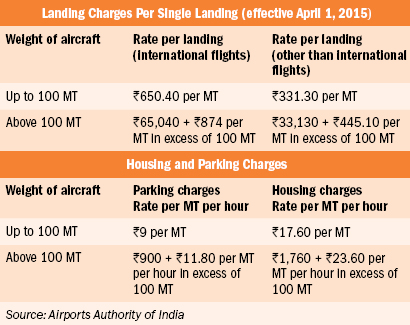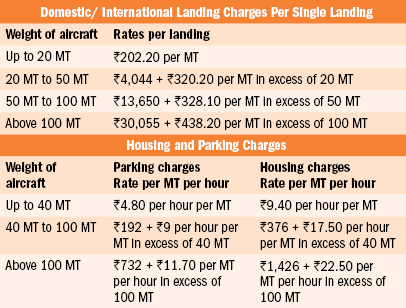INDIAN ARMED FORCES CHIEFS ON
OUR RELENTLESS AND FOCUSED PUBLISHING EFFORTS

SP Guide Publications puts forth a well compiled articulation of issues, pursuits and accomplishments of the Indian Army, over the years

I am confident that SP Guide Publications would continue to inform, inspire and influence.

My compliments to SP Guide Publications for informative and credible reportage on contemporary aerospace issues over the past six decades.
Case for Differential Pricing for Regional Aviation
There are more than 400 airports of which about 90 are operational hence there exists a possibility of a structure of mixed airport charges to boost regional and general aviation services

The Narendra Modi-led government has been talking for quite some time that it would give regional air connectivity a major push. The Minister of Civil Aviation, P. Ashok Gajapathi Raju, on numerous occasions has indicated that the government is serious in promoting regional aviation, first to capitalise on the pan-India economic momentum and two to connect un-served and under-served markets.
Such an effort would mean that the government has to think differently with regard to its civil aviation policy, if it really intends to tap the potential of 300 million middle class citizens living in Tier-II and Tier-III cities. While there are several aspects on how to promote regional aviation, one that is very much under its purview is airport charges wherein it can have a differential pricing for regional airlines, even though there have been murmurs of dissent from major airliners and also private airports.
No direct subsidies
Though there is differential pricing from airport to airport, there is no such differentiation when it comes to full service airlines, low-cost airlines, regional airlines and general aviation. There are no direct subsidies as such for regional airlines. In the light of this, the other alternative is to develop budget airports for regional airlines and low-cost carriers (LCCs) but that model has not been tried out in India.
65 per cent traffic from six airports
There are more than 400 airports of which about 90 are operational hence there exists a possibility of a structure of mixed airport charges to boost regional and general aviation services. Presently, about 65 per cent of India’s air traffic is accounted for by six metros (Delhi, Mumbai, Bengaluru, Hyderabad, Chennai and Kolkata). But it is observed that the smaller towns are going to come in to play soon as there is considerable economic traction happening across the hinterland.
The Airports Authority of India (AAI) is developing about 50 no-frills airports and in the first five are Teju in Arunachal Pradesh, Jharsuguda in Odisha, Hubli and Belgaum in Karnataka and Kishangarh in Rajasthan. In the absence of direct subsidies, no-frills airports do make business sense for regional and general aviation players.
Two heads for charges
The AAI is the authority to levy charges which have been broadly classified under two heads — Air Navigation Services (ANS) and Airport Services. The airports under the AAI have been classified as ‘Major Airports’ and ‘Non-Major Airports’ and the tariff for aeronautical services at major airports is fixed and regulated by Airports Economic Regulatory Authority of India (AERA) and for all other airports the Ministry of Civil Aviation functions as regulator also.
The major airports under AAI are Chennai, Kolkata, Pune, Trivandrum, Jaipur, Goa, Lucknow, Guwahati, Calicut, Ahmedabad and Srinagar. The tariff structure of aeronautical services (other than ANS) at major airports is airport specific. Tariffs for aeronautical services (airport services) pertaining to first control period (financial year 2011-12 to 2015-16) have been approved by AERA in respect of Chennai, Kolkata, Guwahati and Lucknow airports.
Non-Major airports
In respect of the non-major airports the existing tariff for airport services as applicable to domestic airports will continue to be applied though some of them are declared as international airports.
It must be mentioned here that the landing charges at some of the AAI airports are higher than the charges of private airport operators.
A case is being made out that regional airline operators should be incentivised by lower airport charges as they connect under-served or un-served destinations where traffic needs to be created through various promotional schemes. The regional airline operators who operate turboprop and jets with seating capacity up to 130 would stand to benefit if such direct subsidy is provided, but there is no such thinking on the part of the government. The airport charges (for landing, parking and housing) at the Chhatrapati Shivaji International Airport (CSIA) in Mumbai are lower than those charged by the AAI at Kolkata and Chennai. Presently, the AAI has listed out charges for airports and in this article we have included charges of both AAI-run airports and those run by private operators for reference.

Netaji Subhash Chandra Bose International Airport, Kolkata
The AAI charges a minimum fee of Rs. 5,000 per single landing for all types of aircraft/helicopter flights, including but not limited to domestic landing, international landing and general aviation landing, however this will not apply to training flights operated by the flying clubs.
The AAI does not levy any parking fees for the first two hours. It said that while calculating free parking period, standard time of 15 minutes shall be added on account of time taken between touchdown time and actual parking time on the parking stand. Another standard time of 15 minutes shall be added on account of taxiing time of aircraft from parking stand to take off point. These periods shall be applicable for each aircraft irrespective of the actual time taken in the movement of aircraft after landing and before take-off.
Chennai International Airport

Guwahati International Airport

In order to encourage air connectivity to the North-eastern region and to promote intra-regional connectivity the AAI has waived off landing charges for (a) aircraft with a maximum certified capacity of less than 80 seats, being operated by domestic scheduled operators (b) helicopters of all types.
The Airports Authority also has waived off the night parking charges for all domestic scheduled operators at those airports where the state government levies the rate of tax (VAT) on aviation turbine fuel up to 5 per cent. The above waiver of night parking charges (between 2200 to 0600 hours) will be made applicable from the date of implementation of the levy of tax on ATF up to 5 per cent by the respective state governments. This relief shall be applicable initially for a period of five years and will be reviewed thereafter. In the event of upward revision in the tax rate of ATF by the respective state governments the relief of free night parking charges will also be deemed to be withdrawn for all the airports within the jurisdiction of the said state(s).
Charges at Non-major airports

The AAI has stated that all landing and parking charges at all airports in the North-eastern region, Jammu & Kashmir, Andaman and Nicobar Islands and Lakshadweep (other than defence airports) is reduced by 25 per cent of the current rates. All the charges mentioned above do carry applicable service tax.
Private airports —
Chhatrapati Shivaji International Airport, Mumbai

A minimum fee of Rs. 16,170 and Rs. 21,560 is charged per single domestic and international landing respectively for all types of aircraft/helicopter, including but not limited to domestic landing, international landing and general aviation landing.
Pricing in terms of weight
As we notice that the airport charges are made out based on the weight of the aircraft and not as per the classification of full service airline; low-cost carrier; regional airline or general aviation.
Opposition to regional connectivity policy
The Association of Private Airport Operators (APAO) has opposed the regional connectivity policy stating that the destinations included in the proposal lacked traffic potential and the incentives offered to airlines to launch services were not enough to cover their costs. Similarly airlines had opposed stating that the new destinations would have severe financial implications.
The APAO comprises GVK, GMR groups and CIAL run airports at Mumbai, Bengaluru, Delhi, Hyderabad and Kochi. The APAO said that 10 of 87 destinations listed in the proposal have traffic of 70 or more passengers each day to/from Delhi, while the rest “do not have the ability to support or augment scheduled carriers’ service network”. The Civil Aviation Ministry’s proposal says airlines should deploy at least six per cent of the capacity deployed on trunk routes to ‘incentive destinations’ and also on routes within Jammu & Kashmir. In turn, the airlines will be exempt from landing and parking charges, route navigation charges, passenger service fee and fuel throughput charge levied by the Airports Authority of India.
According to the airports’ body, these concessions alone would not be sufficient to incentivise airlines as these don’t even constitute 10 per cent of an airline’s operating cost. In order to break even on these routes, the airlines would require 75 per cent occupancy.
The regional airline operators, presently three in number—Air Costa, Air Pegasus and Turbo Megha Airways (Trujet)—have not grouped themselves to pressure the government as they themselves are in the early stages of their journey. It remains to be seen how the Ministry intends to give regional aviation a boost, other than clearing air operators’ certificate for them at the earliest.





